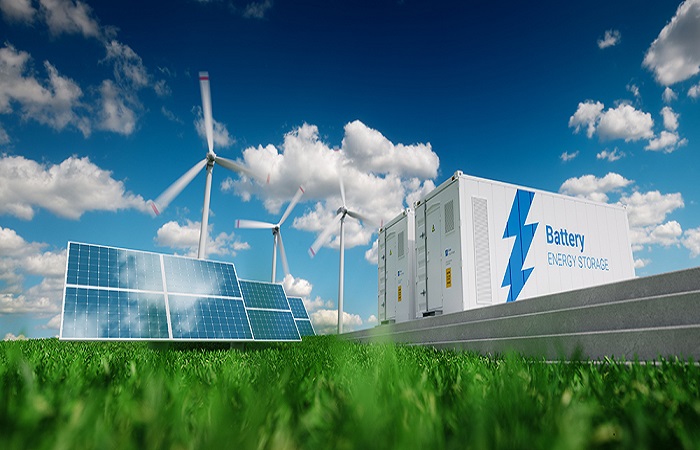New research conducted in Tamil Nadu by Climate Trends and JMK research has found that installing battery-based energy storage capacity in renewable energy-rich states can cost-effectively not only meet the state’s demand but also export surplus enough to power Delhi as compared to coal power.
The researchers designed a hypothetical lithium-ion battery energy storage system (BESS) for Tamil Nadu’s solar and wind power to meet its annual power demand. The system’s capacity and discharge time was set for a decade ending 2030.
The study found that the levelized cost of electricity (LCOE, the average cost of electricity generation for a generating plant over its lifetime) fell from Rs 4.97/kWh in 2021 to Rs 3.4/kWh in 2030 by which time it would meet 29% of the state’s annual power demand at a tariff competitive with the cost of coal power at Rs 4.5-6 kWh. Researchers found that if power was supplied to Delhi, even after including the ISTS charges and states rising power consumption, the solar and wind-powered battery storage system is cost-effective to meet Delhi’s average annual power demand in 2030 by 100%.
Jyoti Guliya of JMK Analytics points put that the cost of hybrid RE with battery storage system was at parity with new coal power plants in Tamil Nadu. “In 10 years incremental capacity addition would further drive down the cost by over 31%. Hybrid RE+storage systems carry a competitive edge compared to tariffs of new coal plants in India which is likely to be in the range of Rs. 4.5 – 6 / kWh in the near future. According to our analysis, the average LCOE rate, considering the 10-year tariff for Tamil Nadu and Delhi scenarios are about Rs. 4.26/ kWh and Rs. 4.96/ kWh respectively.”
The storage system can put an end to state’s wasteful curtailment of clean renewable energy and resolve the issues of intermittency of renewable energy, the study found.
Consider this— Tamil Nadu, India’s top producer of renewable energy, had to curtail nearly 51% of its solar power since April 2020. The curtailment of its wind power was for 3.5 hours per hour in 2019, nearly double the time compared to 2018. Most of this intermittent power is curtailed because of excessive generation and to avoid grid imbalance. But a viable battery storage system that stored and released power after peak solar and wind energy generation hours can prevent such a heavy loss to RE developers, the study found.
Industry experts say the findings are already financially viable for Tamil nadu consumers. “Solar plus energy storage is already a financially viable option for LT commercial consumer and residential slab IV consumers in Tamil Nadu, provided that the system is properly sized. Net Zero is financially viable for LT consumers from 2022 and for LT industrial and Residential slab IV (including subsidy from central) from 2024, in Tamil Nadu,” says Hari Subbish Kumar Subramanian, of Auroville Consulting.
Tamil Nadu’s total installed power capacity as of March 2020 was 33 GW. As of June 2020, Tamil Nadu’s cumulative solar and wind installations stood at 13 GW with an estimated potential of solar and wind energy at 51 GW. The state’s power demand typically varies between 13.5 GW to 16 GW across different seasons, renewable energy meets over 15% of this demand. But adding more intermittent sources of energy to the generation mix can lead to grid imbalance and fluctuations. Another issue is of the control of the power generation according to the demand. as can be done in fossil fuel plant.
The research assessed the impact of storage on grid stability throughout the peaks and lows of RE power in Tamil Nadu. From January to October when the renewable energy is low, the storage provided buffer for short term variation and for evening load management. Between May and July when renewable energy generation is high, the storage helped playing a more critical role by absorbing excess energy.
Experts said high solar and wind energy generation brings its own set of challenges for the state grid operator and the state utility. Grid balancing challenges are expected to exacerbate with the must-run status of RE plants and the limited flexibility of thermal power plants, Sandhya Sundararagavan of WRI pointed out. “The study assessed battery energy storage systems to seamlessly integrate RE into Tamil Nadu’s grid for different RE trajectories in 2025 and 2030 time frames,” she said.
The researchers said because of its intermittent nature and requirement for storage, renewable energy with zero operational emissions is unable to match fossil-fuels which can be ramped up at the rates of several MW/ minute. The study said that even though solar and wind projects are presently awarded at Rs 2.5 kWh, and the average cost of power procurement in India is Rs 3.6 /kWh, renewables have not been able to replace coal to meet sudden demand during peal loading.
Effective energy storage is key to overcoming these challenges. The tariffs of new coal plants in India which are likely to be around Rs 4.5 to 6 kWh in the near future would increase by Rs 0.72 kWh if cost of emission reduction technologies are added. But cost of solar and wind combined with storage is cheaper and their energy is cleaner: average levelized cost of energy (LCOE) rate considering 10-year tariff for Delhi is about 4.96 kWh, the research concluded.
About The Author
You may also like
PMSGY Drives Rooftop Solar Expansion, But Challenges Remain: Report
Global Renewable Energy Capacity to Double by 2030, Led by Solar PV: Report
India’s GST overhaul eases path for India’s green growth
India records second highest solar installations in first half of 2025, surpassing US
Africa’s solar imports surged 60% in the last 12 months: Report

